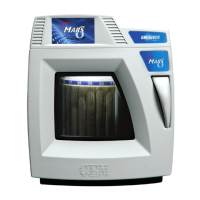4
Compounds Unsuitable for Closed Vessel Microwave Digestion
WARNING
Acid decomposition of certain chemical compounds or types of samples constitutes unreasonable, hazardous
misuse of CEM microwave digestion systems. The classes of compounds listed below are unsuitable for closed
vessel microwave digestion because they are highly reactive with oxidizing acids and/or may become nitrated
and potentially explosive. Absence of a particular chemical compound from this list does not imply microwave
acid decomposition of such a sample is safe under all conditions. CEM will not be responsible for damage to
equipment and facilities or personal injuries resulting from microwave digestion of such compounds/samples.
Explosives (TNT, Nitrocellulose, etc.)
Propellants (Hydrazine, Ammonium Perchlorate, etc.)
Pyrophoric chemicals
Hypergolic mixtures (Nitric Acid and Phenol, Nitric Acid and Triethylamine, Nitric Acid and Acetone, etc.)
Animal Fats (Esters of glycerol capable of nitration and the formation of nitroglycerin or other nitrated organic
compounds)
Aviation Fuels (JP-1, etc.)
Acetylides
Glycols (Ethylene Glycol, Propylene Glycol, etc.)
Perchlorates (Ammonium, Potassium, etc.)
Ethers (Cellosolve - Ethylene Glycol Phenyl ether, etc.)
Lacquers
Alkanes (Butane, Hexane, etc.)
Ketones (Acetone, Methyl Ethyl Ketone, etc.) and alcohols (methanol, etc.)
Chemical Safety Concerns at High Temperature
Mineral Acids
Perchloric ................................................ Dangerous hot
Explosive as dry salt with organics
Decomposes to Cl
2
gas
Sulfuric .................................................... Dehydrating agent
Hydrofluoric ............................................. Biological irritant/very dangerous
Aqua Regia ............................................. Nitrosyl chloride gas irritant
Alkaline Hydroxides
NaOH, KOH, LiOH .................................. Caustic, dehydrating, biological irritants
Peroxides
Hydrogen ................................................. Potent oxidizer
Organic Ethers ........................................ Explosive
Organic Solvents ................................................ Toxicity, explosiveness, flammability, volatility

